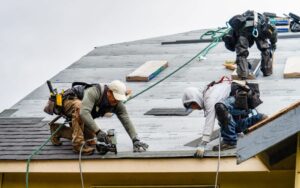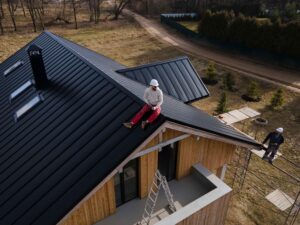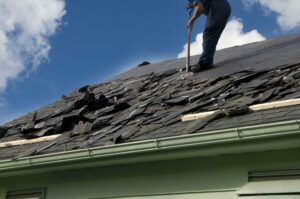When considering roofing options, it’s essential to weigh costs against long-term implications. Asphalt shingles often emerge as the cheapest choice for residential homes, typically ranging from $90 to $100 per square. However, flat roofs like TPO can also provide a budget-friendly alternative. But before making a decision, you need to evaluate other factors that could impact your overall expenses. Let’s explore what these factors are and how they might affect your choice.
Understanding Roofing Costs and Budget Factors
When considering a new roof, understanding the costs and budget factors is fundamental to making an informed decision. First, evaluate the material costs, as different roofing types vary considerably in price. Labor costs also play an important role; skilled contractors may charge more, but their expertise guarantees quality work. Don’t forget to factor in additional expenses like permits, inspections, and potential repairs. Additionally, consider long-term savings on energy efficiency and maintenance when choosing materials. It’s wise to obtain multiple quotes to compare pricing and services. Finally, keep in mind that budgeting for unexpected expenses, such as weather-related repairs, is essential to avoid financial strain. Prioritize transparency and quality when selecting your roofing contractor. While it’s crucial to understand the cheapest roofing options, it’s equally important to know what is the most expensive part of a new roof to fully anticipate your potential investment.
Cheapest Roofing Types for Residential Homes
Several affordable roofing types can greatly reduce your residential roofing costs while still providing effective protection. Asphalt shingles top the list as the most common and economical option, offering ease of installation and a variety of styles. Metal roofing, while pricier upfront, provides exceptional durability and can be a cost-effective long-term investment. TPO roofing is another budget-friendly choice, especially for flat roofs, thanks to its flexibility and longevity. Concrete and clay tiles, although more expensive, deliver impressive durability and aesthetic appeal. To maximize savings, consider affordable underlayment options like felt and guarantee proper installation of components like flashing and ventilation to prevent future costs. Each choice balances affordability with essential protection for your home.
Cost Comparison Table of Common Roofing Types
Understanding the costs associated with various roofing types can help you make an informed decision that fits your budget. Here’s a quick cost comparison of common roofing materials:
- Asphalt Shingles: The most affordable option, typically ranging from $90 to $100 per square.
- Metal Roofing: More durable but costs between $120 to $900 per square, depending on the material type.
- TPO Roofing: A flexible membrane for flat roofs, usually priced around $100 to $150 per square.
- Concrete Tile: Offers durability but can range from $300 to $500 per square due to its weight.
- Clay Tile: High-quality and aesthetically pleasing, costing $400 to $700 per square.
These figures can vary based on installation and regional factors, so always get quotes tailored to your specific project.
Additional Factors That Can Lower Roofing Costs
While considering roofing options, various factors can greatly reduce your overall costs. Selecting the right roof deck material can profoundly impact project expenses; lightweight options often save on labor and materials. Opting for affordable underlayment, such as felt, can also cut installation costs. Proper installation of roof flashing and drip edges directs water away from critical areas, preventing future damage and costly repairs. Ensuring adequate roof ventilation extends your roof’s lifespan, ultimately reducing maintenance expenses. If you’re handy, consider DIY projects like installing asphalt shingles or metal roofing to save on labor costs. These strategies can help maximize your investment while maintaining quality and durability in your roofing project.
When Choosing the Cheapest Roof Makes Sense
Choosing the cheapest roof can make sense when you’re balancing budget constraints with practical needs. If you’re looking for a quick, affordable solution, asphalt shingles are typically the most cost-effective option, offering easy installation and decent durability. For flat roofs, TPO roofing provides a reliable, budget-friendly choice with long-lasting benefits. In addition, if you’re in an area prone to severe weather, opting for a cheaper roof might allow you to allocate funds for immediate storm damage repairs or maintenance. However, consider the long-term implications of lower-cost materials on your home’s overall value and future repair costs. Prioritize essential features like proper ventilation and flashing to guarantee your roof performs effectively while keeping expenses in check.
When to Invest in a More Durable Option
Investing in a more durable roofing option is essential when you expect long-term performance and protection for your home. If you’re planning to stay in your home for years or face extreme weather conditions, opting for materials like metal or TPO roofing can save you money in the long run. These options, though pricier upfront, provide enhanced durability and reduced maintenance costs. Additionally, consider the roofing system’s components; a solid roof deck and efficient ventilation can extend your roof’s lifespan considerably. If you live in an area prone to storms, investing in quality underlayment and flashing can prevent costly water damage. Ultimately, a durable roof not only protects your home but also increases its overall value.
Frequently Asked Questions
How Long Do Cheaper Roofing Materials Typically Last?
Cheaper roofing materials typically last around 10 to 20 years, depending on factors like installation quality and environmental conditions. Regular maintenance can extend their lifespan, but they often require more frequent replacements than higher-quality options.
Can I Install a Cheap Roof Myself to Save Money?
You can install a cheap roof yourself, but it’s risky. Improper installation may lead to leaks and costly repairs. If you’re inexperienced, consider hiring professionals for quality work and long-lasting results. Safety matters too.
What Maintenance Is Required for Low-Cost Roofing Options?
To maintain low-cost roofing options, you’ll need regular inspections, debris removal, and prompt repairs of any damage. Guarantee proper drainage and check for leaks to extend the roof’s lifespan and prevent costly issues down the line.
Are There Any Warranties for Inexpensive Roofing Materials?
Yes, many inexpensive roofing materials come with warranties. These warranties vary in duration and coverage, so you should review each option carefully to guarantee it meets your needs and protects your investment effectively.
How Do Local Weather Conditions Affect Roofing Costs?
Local weather conditions greatly impact roofing costs. You’ll need durable materials for extreme climates, which can increase expenses. Additionally, frequent storms might require more robust installations, affecting both initial costs and long-term maintenance.




